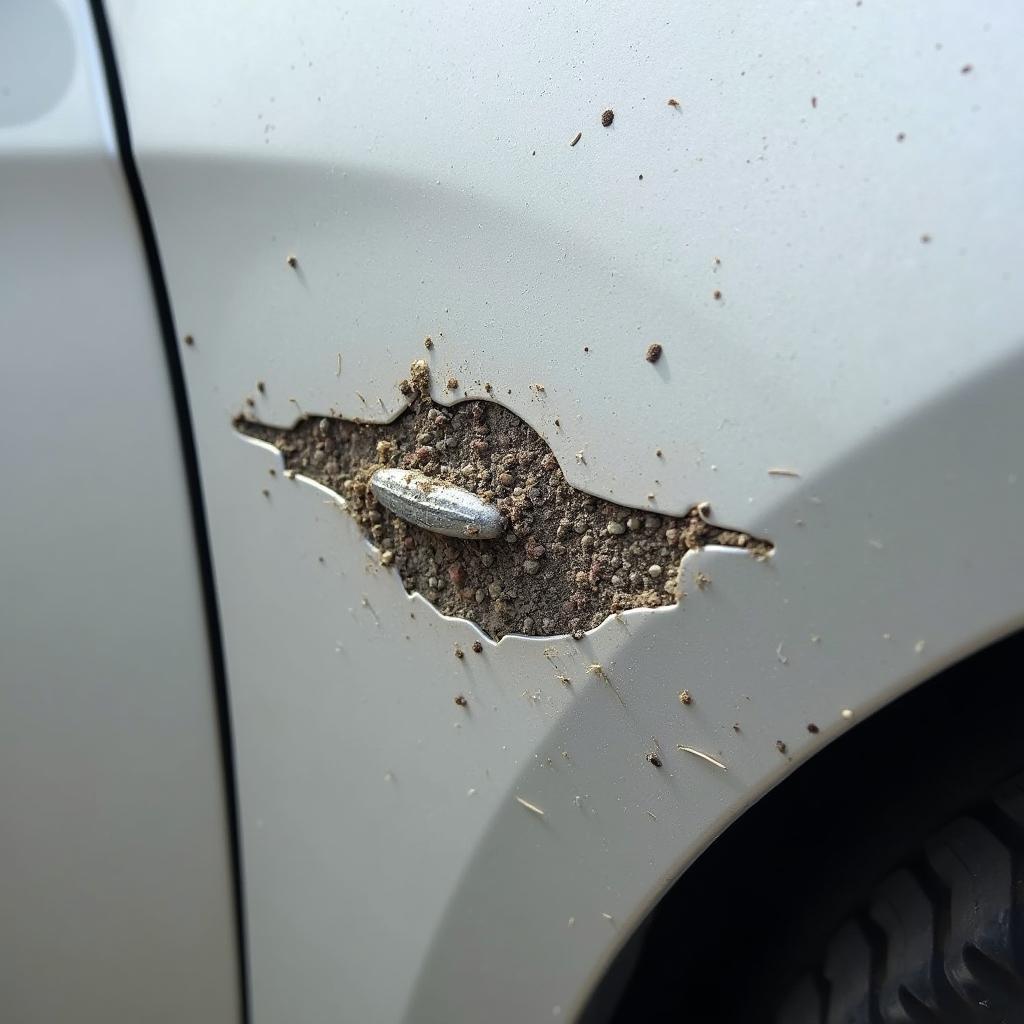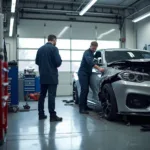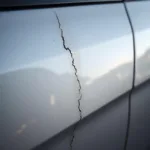Dealing with chipped paint on your car? Whether it’s a minor scratch or a noticeable chip, addressing it promptly is essential to prevent further damage and maintain your car’s appearance. This guide covers everything you need to know about chipped paint repair, from understanding the causes to exploring DIY and professional repair options.
Understanding Chipped Car Paint: Causes and Prevention
Chipped paint occurs when the layers of paint on your car’s surface are damaged, revealing the metal underneath. Common culprits include:
- Road Debris: Small rocks, gravel, and other debris kicked up by tires can chip the paint upon impact.
- Minor Accidents: Fender benders, parking lot mishaps, or even bumping into objects can lead to chipped paint.
- Weather Conditions: Extreme temperatures, UV rays, and hailstorms can weaken the paint’s integrity, making it more susceptible to chipping.
- Tree Sap and Bird Droppings: These acidic substances can etch into the paint if not removed promptly.
Preventing chipped paint involves proactive measures like:
- Regular Washing and Waxing: Keeps the paint protected and makes it harder for debris to stick.
- Careful Driving and Parking: Maintaining a safe distance from other vehicles and choosing parking spots wisely reduces the risk of minor collisions.
- Touch-Up Paint: Having your car’s touch-up paint handy allows you to address minor chips before they worsen.
DIY Chipped Paint Repair: Options and Steps
For minor paint chips, DIY repair kits can be a cost-effective solution. Here’s a breakdown of the process:
1. Assess the Damage
Examine the severity of the chipped paint. If it’s a small chip that hasn’t reached the metal, a DIY approach is suitable. For larger chips or rust formation, consulting a professional is recommended.
2. Gather Your Supplies
You’ll need:
- Touch-up paint (matching your car’s paint code)
- Automotive primer (if the metal is exposed)
- Sandpaper (fine-grit)
- Rubbing alcohol
- Microfiber cloths
- Car wax
3. Prepare the Area
Clean the chipped area thoroughly with soap and water. If rust is present, gently sand it down. Use rubbing alcohol to remove any grease or residue.
4. Apply Primer (If Necessary)
If the metal is exposed, apply a thin coat of automotive primer to the chipped area and let it dry completely.
5. Apply Touch-Up Paint
Carefully apply thin layers of touch-up paint, allowing each layer to dry before applying the next. Avoid applying too much paint, as it can lead to an uneven finish.
6. Level and Blend
Once the paint is dry, use fine-grit sandpaper to gently level the repaired area with the surrounding paint. Be careful not to sand too aggressively.
7. Wax and Polish
After sanding, apply car wax to the repaired area and surrounding paint to protect it and restore shine.
repair serious door ding chipped paint on car
When to Seek Professional Chipped Car Paint Repair
While DIY solutions work for minor chips, professional repair offers several advantages:
- Expertise and Color Matching: Professionals possess the skills and equipment for seamless repairs, including precise color matching.
- Durable and Long-Lasting Results: Professional repairs are less likely to chip or fade over time.
- Time-Saving: Leave the repair process to the experts and avoid the hassle of DIY.
Chipped Car Paint Repair Cost: Factors to Consider
The cost of professional chipped paint repair varies based on:
- Severity and Size of the Damage: Larger areas or deep chips require more extensive work.
- Location of the Damage: Repairs on complex curves or body lines can be more labor-intensive.
- Type of Repair: Spot repairs cost less than panel repainting.
- Shop’s Labor Rates: Different shops have varying hourly rates.
Choosing the Right Car Paint Repair Solution
Deciding between DIY and professional repair depends on your budget, time constraints, and the extent of the damage. For small, isolated chips, a DIY kit can be sufficient. However, for larger areas, significant color matching issues, or if you’re unsure about the process, seeking professional help is advisable.
Conclusion
Chipped paint is a common car problem, but addressing it promptly is crucial. By understanding the causes, prevention methods, and repair options, you can make informed decisions to keep your car looking its best. Remember, whether you opt for a DIY fix or consult a professional, timely action is key to restoring your car’s appearance and preventing further damage.



